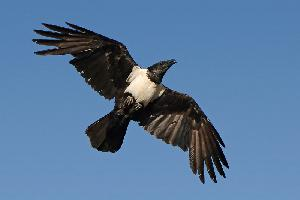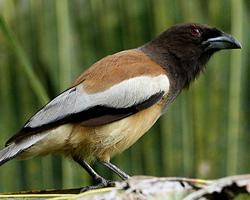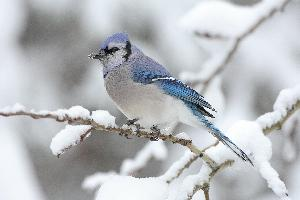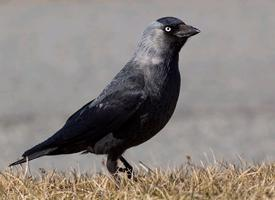
Poids et mesures
| Longueur | de 46 à 50 cm |
|---|
Description de l'animal
The Pied Crow (Corvus albus) is a distinctive and relatively large bird species belonging to the crow family, Corvidae. This striking bird is widely distributed across Sub-Saharan Africa, where it thrives in a variety of habitats including savannahs, coastal areas, open woodlands, and urban environments. The Pied Crow is known for its remarkable adaptability, intelligence, and the unique, contrasting plumage that gives it its name.Characterized by its black and white coloration, the Pied Crow presents a sleek and eye-catching appearance. The majority of its body is cloaked in glossy black feathers, which cover the head, throat, wings, and tail. In stark contrast, its underparts, from the neck down to the belly, are adorned with pure white feathers, creating a stark and appealing visual contrast that is easily recognizable. This crow's face features a powerful black beak, known for its versatility in foraging and tool use, and keen, observant eyes that exhibit a high degree of intelligence and awareness of its surroundings.
Adult Pied Crows are sizeable birds, typically measuring around 45 to 50 centimeters in length, with a wingspan that can extend up to one meter. This size, coupled with their strong flight capabilities, allows them to cover large distances in search of food. Their diet is notably varied, encompassing a wide range of items including insects, small vertebrates, eggs, carrion, and even human food waste, showcasing their opportunistic and adaptable nature.
One of the most fascinating aspects of the Pied Crow is its remarkable intelligence. Like many corvids, Pied Crows have demonstrated a capacity for problem-solving, tool use, and even some level of social organization. They are known to work in pairs or groups to achieve goals, and there are anecdotal reports of Pied Crows utilizing tools, such as using sticks to extract insects from tight spaces, showcasing their ingenuity.
The vocalizations of the Pied Crow are as varied as their diet, ranging from harsh caws to more complex sequences of sounds that can resemble musical patterns. These vocal skills not only facilitate communication among crows but also play a role in their social structure and mating rituals.
Pied Crows are monogamous birds, typically forming long-term pair bonds. Their nests are large structures made of sticks and lined with softer materials, usually built in tall trees or sometimes on man-made structures. Both parents are involved in rearing the young, which emphasizes the strong social bonds within these birds.
Despite facing threats from habitat destruction and pollution, the Pied Crow remains widespread and is not currently considered endangered. Their adaptability to human-altered landscapes has allowed them to maintain stable populations, even thriving in urban areas where their intelligence allows them to exploit new resources.
In conclusion, the Pied Crow is a remarkable bird, not only for its striking appearance but also for its adaptability, intelligence, and complex social behaviors. As a common sight across much of Sub-Saharan Africa, it stands as a testament to the resilience and versatility of the avian world.
Carte de répartition
Animaux similaires
Nouvelles photos d'animaux
Top 10 des animaux
- Dolphin gull (Leucophaeus scoresbii)
- Diana monkey (Cercopithecus diana)
- Moustached guenon (Cercopithecus cephus)
- Galápagos tortoise (Geochelone nigra complex)
- Japanese macaque (Macaca fuscata)
- Stone loach (Barbatula barbatula)
- Russian tortoise (Testudo horsfieldii)
- Greek tortoise (Testudo graeca)
- Common flying dragon (Draco volans)
- Vendace (Coregonus albula)


